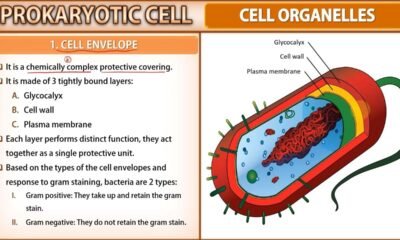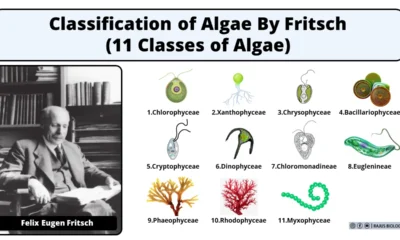Blog
Classification of Fungi by Alexopoulos and Mims (1979)
In this article we will discuss about Classification of Fungi by Alexopoulos and Mims (1979)
Classification of Fungi by Alexopoulos and Mims (1979)
- C. J. Alexopoulos and C. W. Mims (1979) placed fungi and slime molds under their own kingdom called Myceteae.
- The kingdom fungi is divided into 3 divisions, 8 subdivisions, 11 classes and 1 form class
Kingdom: Myceteae (Fungi)
- Achlorophyllous
- Heterotrophs
- Unicellular or filamentous soma (thallus)
- Chitinous cell wall
- Reserve food material is glycogen and oil droplets
- On the basis of presence or absence of cell wall, centriole and flagellate cells in life cycle, the kingdom myceteae divided is into three major divisions: Gymnomycota, Mastigomycota and Amastigomycota
Division I: Gymnomycota
- Phagotrophic organism
- Lack of cell walls
- This division comprises two subdivisions: Acrasiogymnomycotina and Plasmodiogynomycotina
Subdivision 1. Acrasiogymnomycotina
- These are Commonly known as cellular slime molds
- They exist as individual amoeboid cells
- Under unfavourable condition, these individual cells aggregate to form a multicellular slug-like structure called a pseudoplasmodium.
- It includes a single class Acrasiomycetes.
Class : Acrasiomycetes
- Most abundantly found in upper layers of humus in well established deciduous forests and as well as in soils.
- Flagellated cells absent.
- E.g., Dictyostelium
Subdivision 2. Plasmodiogymnomycotina
- These are commonly known as plasmodial slime molds.
- They exist as multinucleate mass of protoplasm called a plasmodium
- The plasmodium engulfs food particles as it moves and grows.
- It is divided into two classes: Protosteliomycetes and Mycomy
Class : Protosteliomycetes
- Primitive slime molds, mostly found in soil, dung, humus, dead wood, tree bark and plant remains.
- Myxamoebae do not aggregate before fruiting.
- E.g., Protostelium
Class : Mycomycetes
- True slime molds, distributed world wide, found on moist soil, decaying wood and dung.
- Sometimes fruiting bodies are conspicuously coloured.
- E.g., Physarum, Fuligo
Division II: Mastigomycota
- Absorptive nutrition
- Mycelium is coenocytic
- Fungi with centrioles
- Flagellate cells produced during life cycle
- Asexual reproduction typically by zoospores
- This division comprises two subdivisions: Haplomastigomycotina and Diplomastigomycotina
Subdivision 1: Haplomastigomycotina
- They are flagellate fungi, producing either uniflagellate or biflagellate zoospores
- Life cycle either haplobiontic (haploid) or diplobiontic (diploid)
- Some are aquatic, while others are endoparasitic slime moulds.
- It is divided into three classes: Chytridiomycetes, Hyphochytridiomycetes and Plasmodiophoromycetes
Class : Chytridiomycetes
- Occur commonly in aquatic habitats and many in soil.
- Posteriorly attached uniflagellate zoospores, flagella whiplash type.
- E.g., Chytrids, Allomyces
Class : Hyphochytridiomycetes
- Aquatic fungi found in fresh and marine conditions.
- Thallus may or may not bear rhizoids.
- Anteriorly attached uniflagellate zoospores.
- Flagella tinsel type.
- E.g., Rhizidiomyces, Hyphochytrium
Class : Plasmodiophoromycetes
- They are obligate endoparasites.
- Attaching many economically important plants like cabbage and potato.
- Life cycle includes two district plasmodial phases.
- Zoospores are biflagellate, flagella unequal in length, anterior and whiplash type.
- E.g., Plasmodiophora
Subdivision 2: Diplomastigomycotina
- They are flagellate fungi, producing latral biflagellate zoospores (one whiplash and another tins flagellum)
- Sexual reproduction is oogamous type.
- It includes a single class Oomycetes
Class : Oomycetes
- Found in a variety of habitats, majority are aquatic.
- Live parasitically on algae, water molds, aquatic insects and other animals and plants.
- Mycelium is well branched, filamentous and coenocytic.
- Cell wall contains cellulose.
- Many members produce non-motile conidia.
- E.g., Pythium, Phytophthora
Division III: Amastigomycota
- Absorptive nutrition
- Mycelium aseptate or septate
- Fungi without centriole
- Motile cells are absent throughout life cycle
- This division comprises four subdivisions: Zygomycotina, Ascomycotina, Basidiomycotina and Deuteromycotina
Subdivision 1: Zygomycotina
- The hyphae is coenocytic (lacking septa, multinucleate)
- Asexual reproduction by non-motile spores (Aplanospores) produced in sporangia and no zoospores produced
- Sexual reproduction by zygospore produced by the fusion of two morphologically identical gametes.
- It is divided into two classes: Zygomycetes and Trichomycetes
Class : Zygomycetes
- Mostly terrestrial in habitat, living in soil or on decaying plant or animal material.
- Some are parasites of plants, insects, while others form symbiotic relationships with plants.
- Mycelium coenocytic, forming septa only where gametes are formed.
- Perfect stage condition is zygospore.
- E.g. Rhizopus, Phycomyces
Class : Trichomycetes
- These fungi are parasitic, found within the digestive tract of living arthropods and guts of earthworms.
- The hosts of Trichomycetes include marine, freshwater and terrestrial arthropods.
- Asexual reproduction takes place by trichospores, sporangiospores, arthrospores or amoebiod cells.
- Sexual reproduction takes place by biconial zygospores.
- E.g. Smittium
Subdivision 2: Ascomycotina
- They are called higher fungi and more complex in structure
- A short-lived dikaryotic stage is present in-between plasmogamy and karyogamy.
- It includes a single class Ascomycetes
Class : Ascomycetes
- Commonly known as sac-fungi, mostly fungi are multicellular or rarely unicellular e.g. yeast.
- They are saprophytic, decomposers, parasitic or coprophilous.
- Perfect stage condition is ascospores, 8 ascospores produce in sac like structure called as ascus, asexual spores are conidia produced exogenously on conidiophores.
- Conidia on germination produce mycelium.
- E.g. Penicillium, Aspergillus and Neurospora
Subdivision 3: Basidiomycotina
- They have septate mycelium
- produces basidiopores (meiospores) exogenously on basidia.
- It includes a single class Basidiomycetes
Class : Basidiomycetes
- They are terrestrial, saprophytic or parasitic.
- Saprophytic fungi cause decay of wood, litter, dung, wet leaves and other organic matter.
- Many toadstools form mycorrhizal associations wither higher plants and prove extremely valuable in nature.
- The hyphae penetrate the substratum to absorb the food.
- The mycelium is of primary, secondary and tertiary types.
- Dolipore septa are present in most of the genera.
- They reproduce asexually by conidium, arthrospore, oidia, fragmentation or budding.
- The perfect state spores are basidiospore, which develops on a basidium.
- E.g. Agaricus, Puccinia, Pleurotus etc.
Subdivision 4: Deuteromycotina
- It includes imperfect fungi in which sexual stage is unknown.
- The members of this class mostly resemble to Ascomycetes and Basidiomycetes in structure and reproduction.
- It includes a single form class Deuteromycetes
Form class : Deuteromycetes
- The deuteromycetes are commonly called fungi imperfecti or imperfect fungi
- They are saprophytes as well as parasites. Parasitic fungi cause serious diseases to plants, animals including human beings.
- They reproduce asexually by conidia along with some other types of spores.
- The sexual reproduction is entirely absent.
- E.g., Alternaria, Fusarium, Helminthosporium etc.
Reference
Sullia, S. B., & Shantharam, S. (2019). General Microbiology. Oxford and IBH Publishing.
Sinha, A. K. (1962). Botany for degree students fungi. S. Chand Publishing.
Devasahayam, H. L. (2009). Illustrated plant pathology: Basic Concepts. New India Publishing.
Aryal, S. (2022, September 5). Classification of Fungi by Alexopoulos and Mims. Microbe Notes. https://microbenotes.com/classification-of-fungi/

 Blog5 months ago
Blog5 months ago[PPT] Human Reproduction Class 12 Notes
- Blog5 months ago
Contribution of Indian Phycologists (4 Famous Algologist)
- Blog5 months ago
PG TRB Botany Study Material PDF Free Download

 Blog5 months ago
Blog5 months agoCell The Unit of Life Complete Notes | Class 11 & NEET Free Notes

 Blog5 months ago
Blog5 months ago[PPT] The living world Class 11 Notes

 Entertainment5 months ago
Entertainment5 months agoIbomma Bappam: Redefines Telugu Streaming Trend
- Blog5 months ago
Class 12 Biology Notes Chapter wise PPT

 Blog5 months ago
Blog5 months agoClassification of Algae By Fritsch (11 Classes of Algae)












